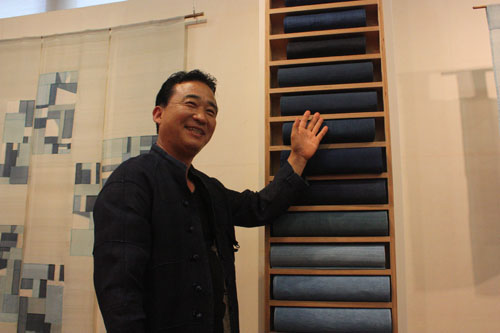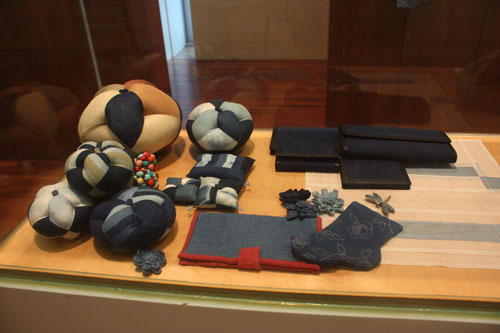중요무형문화재 제115호 정관채 염색장
Jjock Yeomsaek
: An Endless Desire to Gain a Color of the Sky
By Son Hyun-jee, Tribune Reporter
There are five Korean traditional colors called Ohbangsaek. The color for the east is blue, white is for the west, red is for the south, black is for the north, and yellow is for the center. No one can deny that the blue (indigo) color represents Korean sentiments best of them all. The geographical location of the Korean Peninsula is in the east, that is why the blue color has been revered. Jjock, the most important material for indigo dyeing, is famous not only for its unchanged vivid color but also for its medical effect that treats skin diseases. Therefore, Jjock yeomsaek, the indigo dyeing, has been vital for many special uses from the old times. This is a special material for not only the Royal Family’s Doyeomseo, the palace’s dye house, but also ordinary people who prepared indigo dyed skirts and bedclothes for their special weddings.

Yeoungsan River in Jeollanam-do floods periodically. However, Jjock (an indigo plant) has lots of joints and it cannot be easily swept away by these floods. People who lived on the shores of the Yeoungsan River have grown Jjock instead of rice. The region is also known for Saetgolnai, traditional hand-woven cotton. Naju can be a proper place to have the optimum conditions for indigo dyeing. Jung Gwan-chae, which was designated as an Important Intangible Cultural Property of Korea Number 115 in 2001, also has kept the traditional work of dyeing for about thirty years in Naju. After the Korean War, natural dyes had gradually disappeared due to the influx of artificial dyes. Jung kept studying and working for Jjock, thereby he could keep the tradition of Jjock dyeing alive. “It was really hard to reproduce the beautiful color of our ancestors, Indigo that resembles the blue sky. That is the color which I have always dreamed of.” He added the best color of Jjock is indigo slightly mixed with the color purple.
“I deal with the job in all sincerity as if raising my children.” It is really hard and it takes a long time to dye the color of Jjock. Jung has a big farm more than 33,000 square meters allocated only for Jjock. He sows the seeds in the huge field in March and harvests it in July in the scorching heat. It is really important to harvest the plant before it blooms. Then, the artisan puts the plants and water together in a big jar and removes the root crop later. The water turns into a bluish green. He grinds baked shells of oysters and stirs the water with the powder. This base becomes the dye, called niram. Next, he must dry the removed Jjock and burn it in the furnace until it becomes ash. Then he pours boiling water into the ash, and blends the lye with niram. Finally, stirring it and fermenting itwith water at 25 to 30 degrees Celsius will finalize the process. In these complex processes, profound chemical principles are hidden such as oxidation, reducing process and fermentation of live microorganism. We can get the magical indigo color from green Jjock only with lime powder and lye. That is the wonderful power of nature.

Jung is one of the five artisans who are Important Intangible Cultural Property introduced in a Smartphone application named The Korea Spirit. In this application, we can see his dyeing process as if he is working right next to us. Not just asking for attention to be paid to traditional Jjock yeomsaek, Jung also stressed choosing ‘the road not taken’ for university students. “People did not understand why I worked for dyeing at that time. They probably thought dyeing was vain.” While he chose what he really wanted to do, honor and money naturally followed him later.
Naju has become a Mecca of Jjock dyeing. Jung Gwan-chae has worked hard for teaching dyeing skills. He holds classes pro bono for people who really want to learn how to dye. Moreover, the numbers of foreigners who visit Naju to watch and learn how to dye with Jjock has been increasing. An Environmentally-friendly Dyeing Industrial Center is also being built in Naju and it will be the best dyeing center in Korea. It is time to pay attention to our traditional dyeing culture.
손현지 기자
qhsmldkdl@naver.com

